The Amatuer Mycologist - Random Find - Probable Flammulina velutipes, The Velvet Foot
These posts are not for foraging. They are intended for entertainment and intellectual satisfaction only. These posts are not a field guide nor comprehensive in any way - their accuracy is not assured in any way. Do not eat wild mushrooms unless you are a professional, have substantial professional assistance or have a wealth of personal experience with a specific species. Do not make any foraging decisions based on these posts. To do so could be dangerous or life threatening.
These Posts Contains No Information Regarding Edibility Or Toxicity
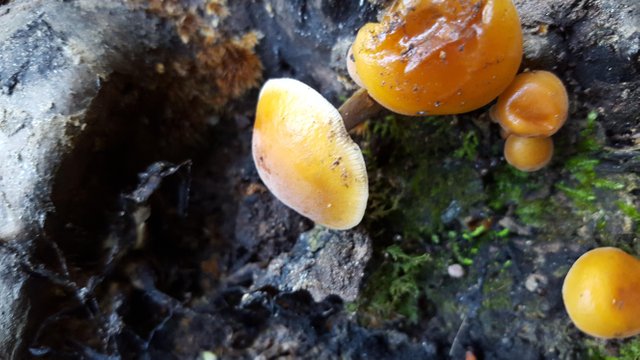
I found these fiery, viscid (sticky) little guys in PA
They were hanging around the perimeter of a giant, long dead tree burr. The corpse of the tree fell some time ago, and cut right across the path we were walking on.
Whereas most of the mushrooms I found were dessicated - or worse, in a state of moist decomposition - these bright, beautiful little mushrooms were fresh as the morning dew.
Take a look at the log from which they sprouted
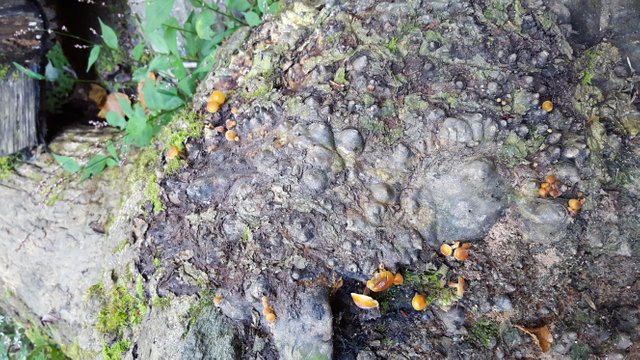
The fact that these mushrooms are saprobic is important
As is they're intense coloration and their viscid cap - viscid being a synonym for sticky. There is a mushroom, known by several aliases - the winter mushroom, the velvet stem, or the velvet foot - whose species name is Flammulina velutipes.
This mushroom is fairly ubiquitous in North America, east of the Rocky Mountains. It grows in deciduous forests on the dead wood of deciduous trees, or sometimes the dying but not yet dead wood of such trees.
The caps tend not to get bigger than 6 or 7cm across, and can grow up to 11cm high according to Kuo, although none of the ones I saw here achieved that feat.
However, the flame colored, sticky cap, growth medium, and size are not automatic giveaways for the species. Two other traits are very important.
First, these are called velvet stem mushrooms for a reason. Let's flip one over
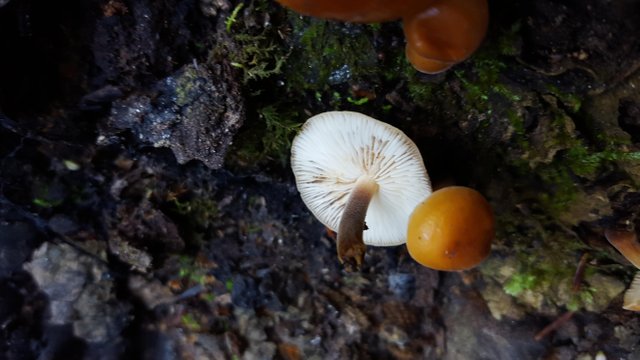
Take a look at the velvety stem
As well as the coloration if the stem. It is light whitish or yellowish at the top, near the cap, but brown throughout the rest.
There is a fine velvety-ness to the whole length of the stem. Importantly, there is also no ring, or annulus, on the stem. This is a good sign. If there was a ring, then this might not be F.velutipes but a lookalike mushroom Galerina marginata, previously known as G. autumnalis.
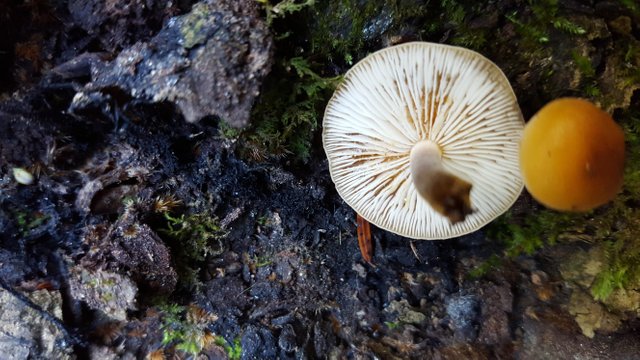
However, once again the lack of an annulus is still not dispositive. Sometimes the ring, which is the remnants of a veil that used to cover the gills, comes off as the mushroom ages.
In order to further confirm the species, a spore print of each specimen is required. F.velutipes has a white print.
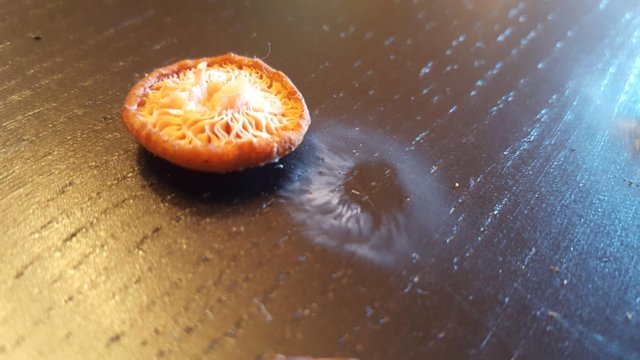
White!
This spore print was achieved by leaving the mushroom on a black wooden table for 12 hours. Normally I prefer to do my prints on clear glass, but I had none available in PA.
Plus I already new that there were only two realistic possibilities: either the print would be white, in which case this was almost certainly F.velutipes; or the print would be brown and hardly visible on the table and confirmable with a wet Q-tip.
But since the print turned out white, in conjunction with the other macro-characteristics we've identified, we can be fairly certain that these mushrooms are F.velutipes.
It's worth noting here that just because the few I picked for ID'ing turned out to be F.velutipes, does not mean the rest around that stump were. Tom Volk is quick to point out that G.autumnalis sometimes grows right alongside F.velutipes. So to be certain of an ID, each individual mushroom really ought to be printed.
With fall coming up - in theory anyway - be on the look out for F.velutipes on your nature walks. It's called the winter mushroom for a reason and you're liable to stumble upon it even in winter time, calling out to you like tony campfires in the snow.
Photos are all my own
Information Sources:
[1]Kuo On the F.velutipes
[2]Tom Volk on F.velutipes
[3]Wikipedia on F.velutipes
You should include this fungi in another misconception post. Most people don't know that F. velutipes and store-bought enokis are the same mushroom.
Great piece by the way!
I was amazed to discover that! I was planning on eventually doing a full species rundown of velutipes in the future that talked about that. In the mean time Tom Volk goes into a lot of detail about how Enoki's are coerced into their uniqur form.
It's that kind of thing that still blows my mind now and again when I discover new species in perspn for the first time.
amazing what can be achieved through "cultivation" (and that relates to many other more "esoteric" mushrooms as well)! lol
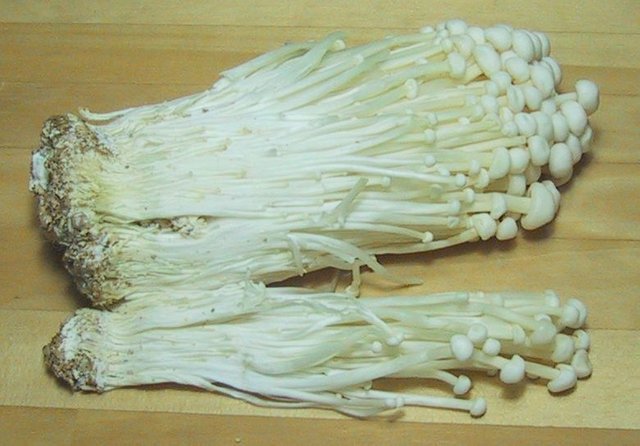
Fungi are so amazing! And the more people study them and cultivate them, too, the more we find how amazing they are. I like examples of cultivated mushrooms that occur in the wild, too. It can help people fear them less.
I was just planning to go to the Siberian forest tomorrow to take a walk and collect mushrooms
Lucky you! My best mushroom hunt was in a Russian forest - harvested a bucket of chanterelles.
)))) chanterelle good mushroom, chanterelles I love.
You got my vote and a resteem :]
When I lived in Michigan in the 1980s, it was inevitable that sometime during the autumn, somebody would not look closely at every one of the mushrooms that they harvested - and they would get some of the poisonous Galerina species mixed in with their little brown edible mushrooms, like the Flammulina velutipes, the Armellariella mellea, or the Pholiota mutabilis. So, so sad.
That's tragic - I hope no one was killed. It is a very dangerous and common miss identification as I understand it.
Edit: Sorry, I am having some issues with comments when I post them in Esteem. Just realized this one was cut off.
Great post! I usually just take photos of unfamiliar mushrooms, but you went into a deep resource. Keep up the good work. Would love to read more about different types of mushrooms from the amateur mycologist.
The internet is a great place to start when you encounter a mushroom you aren't familiar with. If you're just learning to ID and appreciate mushrooms more, the
I just found you and now following you. My wife is from Russia and knows mushrooms very well. I went hunting them with her there and loved it. We are just back from Alaska on a cruise and went into the forest a few times and she knew the names of many of the ones we found there. I have some photos I will share later in a post.
Awesome - I'll keep an eye out for that!
Great post, very interesting to read, I do not know almost anything about mushrooms but I find it interesting
I'm glad! Fungi are super varied and really amazing organisms
Good information
Nice work
I saw these mushrooms in the forest this weekend. They look great but they aren't edible.
I invoke the fifth amendment on all issues involving edibility
Mushrooms which are usually found in the forest are dangerous. Some are edible, but we can't tell just by looking at it sometimes.
good like @mosabhelal